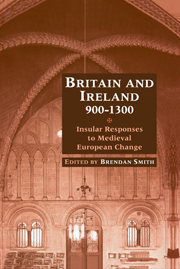Book contents
- Frontmatter
- Contents
- Contributors
- Preface
- List of abbreviations
- 1 The effect of Scandinavian raiders on the English and Irish churches: a preliminary reassessment
- 2 The changing economy of the Irish Sea province
- 3 Cults of Irish, Scottish and Welsh saints in twelfth-century England
- 4 Sea-divided Gaels? Constructing relationships between Irish and Scots c. 800–1169
- 5 The 1169 invasion as a turning-point in Irish-Welsh relations
- 6 Killing and mutilating political enemies in the British Isles from the late twelfth to the early fourteenth century: a comparative study
- 7 Anglo-French acculturation and the Irish element in Scottish identity
- 8 John de Courcy, the first Ulster plantation and Irish church men
- 9 Coming in from the margins: the descendants of Somerled and cultural accommodation in the Hebrides, 1164–1317
- 10 Nobility and identity in medieval Britain and Ireland: The de Vescy family, c. 1120–1314
- Bibliography
- Index
3 - Cults of Irish, Scottish and Welsh saints in twelfth-century England
Published online by Cambridge University Press: 30 July 2009
- Frontmatter
- Contents
- Contributors
- Preface
- List of abbreviations
- 1 The effect of Scandinavian raiders on the English and Irish churches: a preliminary reassessment
- 2 The changing economy of the Irish Sea province
- 3 Cults of Irish, Scottish and Welsh saints in twelfth-century England
- 4 Sea-divided Gaels? Constructing relationships between Irish and Scots c. 800–1169
- 5 The 1169 invasion as a turning-point in Irish-Welsh relations
- 6 Killing and mutilating political enemies in the British Isles from the late twelfth to the early fourteenth century: a comparative study
- 7 Anglo-French acculturation and the Irish element in Scottish identity
- 8 John de Courcy, the first Ulster plantation and Irish church men
- 9 Coming in from the margins: the descendants of Somerled and cultural accommodation in the Hebrides, 1164–1317
- 10 Nobility and identity in medieval Britain and Ireland: The de Vescy family, c. 1120–1314
- Bibliography
- Index
Summary
In the twelfth century the constituent parts of the British Isles came to be bound together in new ways. Sometimes this involved consciously aggressive military and political action resulting in the subordination of some areas to authorities based in other parts of the islands; sometimes it stemmed from emulation by the ruling classes of one region of the institutions, techniques and culture of elites elsewhere; and beneath all this there was a process of convergence and assimilation which can best be seen as part of the wider European scene of migration and cultural change. This increased contact can be studied in a dozen fields – coinage, kingship, vernacular literature, feudalism, urbanism and so forth, but the purpose of this paper is to look at the minor, but relatively unexplored, case of saintly cult.
In theory saints are international and hence easily transportable. In reality, of course, individual cults often had strong regional, national and other particularist associations and characters. Below the level of the great biblical saints, like Mary, Peter and John, the early medieval saints of England, Ireland, Scotland and Wales are easily distinguishable. Of the eighty-nine saints listed in the early eleventh-century inventory of saints' resting places in England, the vast majority are Anglo-Saxon kings, bishops and heads of religious communities, especially those of the conversion period.
- Type
- Chapter
- Information
- Britain and Ireland, 900–1300Insular Responses to Medieval European Change, pp. 67 - 86Publisher: Cambridge University PressPrint publication year: 1999
- 5
- Cited by

